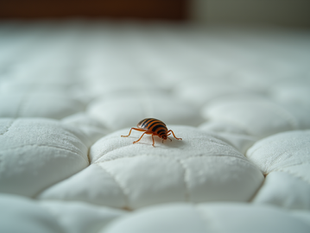
How to Spot the Early Signs of a Bed Bug Infestation
0
23
0
Bed bugs are tiny pests that can quickly turn your home into an uncomfortable place. Detecting their presence early is crucial to prevent a full-blown infestation. Knowing the bed bug signs can save you time, money, and stress. This guide will help you identify the early warning signals and take action before the problem worsens.
Recognizing the Most Common Bed Bug Signs
Bed bugs are elusive creatures, but they leave behind clues. Here are some of the most common bed bug signs to look out for:
Bite marks on your skin: Bed bug bites often appear as small, red, itchy bumps, usually in a line or cluster. They commonly show up on exposed skin areas like arms, neck, and face.
Blood stains on sheets or pillowcases: After feeding, bed bugs may leave tiny blood spots on your bedding.
Dark or rusty spots on mattresses and furniture: These spots are bed bug excrement and can be found near their hiding places.
Shed skins and eggshells: Bed bugs molt as they grow, leaving behind translucent skins and tiny white eggs.
A musty, sweet odor: In heavy infestations, a distinct smell similar to coriander or almonds may be noticeable.
If you notice any of these signs, it’s time to act quickly.

How to Conduct a Basic Bed Bug Inspection at Home
You don’t need special tools to start checking for bed bugs. Here’s a simple step-by-step guide to inspect your home:
Start with the bed: Remove all bedding and check seams, folds, and tags of your mattress and box spring.
Examine furniture: Look inside cracks, crevices, and joints of bed frames, nightstands, and chairs.
Check behind baseboards and electrical outlets: Bed bugs can hide in small, dark spaces.
Use a flashlight and magnifying glass: These tools help you spot tiny bugs, eggs, or fecal spots.
Look for live bugs: Adult bed bugs are about the size of an apple seed, reddish-brown, and flat.
Be thorough and patient. Inspections can take time but are essential for early detection.

What Happens During a Bed Bug Inspection?
When you hire a professional bed bug inspection service, the process is more detailed and accurate. Here’s what typically happens:
Initial assessment: The inspector asks about any signs you’ve noticed and areas of concern.
Visual inspection: Using specialized tools, the inspector examines your mattress, furniture, walls, and other potential hiding spots.
Use of detection dogs: Some services employ trained canines that can sniff out bed bugs with high accuracy.
Documentation: The inspector records findings and may take photos for evidence.
Recommendations: Based on the inspection, you receive advice on treatment options or prevention measures.
Professional inspections are invaluable because they can detect infestations that are not obvious to the untrained eye.

If you suspect an infestation but are unsure, consider contacting a bed bug inspection service to get a thorough and reliable evaluation.
Preventing Bed Bug Infestations: Tips and Best Practices
Prevention is always better than cure. Here are some practical steps to reduce the risk of bed bugs invading your home:
Inspect secondhand furniture before bringing it inside.
Use protective covers on mattresses and box springs.
Reduce clutter to eliminate hiding spots.
Vacuum regularly, especially around beds and furniture.
Be cautious when traveling: Inspect hotel rooms and keep luggage off the floor.
Seal cracks and crevices in walls and baseboards.
By following these tips, you can minimize the chances of bed bugs settling in your living space.
Taking Action Early: Why Prompt Detection Matters
Ignoring early bed bug signs can lead to a severe infestation that is harder and more expensive to eliminate. Early detection allows for:
Less extensive treatment: Smaller infestations require fewer chemicals and less disruption.
Reduced health risks: Bed bug bites can cause allergic reactions and secondary infections.
Peace of mind: Knowing your home is pest-free improves your comfort and well-being.
If you notice any suspicious signs, act immediately. Early intervention is the key to keeping your home bed bug-free.
By learning to spot the early bed bug signs and knowing what to do next, you can protect your home and family from these unwelcome pests. Stay vigilant, inspect regularly, and don’t hesitate to seek professional help when needed.






